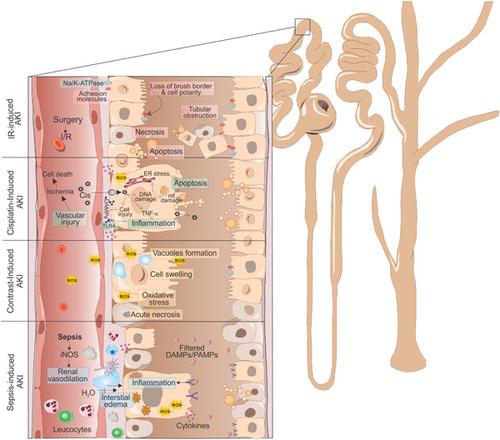当前位置:
X-MOL 学术
›
J. Cell. Physiol.
›
论文详情
Our official English website, www.x-mol.net, welcomes your feedback! (Note: you will need to create a separate account there.)
Molecular pathophysiology of acute kidney injury: The role of sirtuins and their interactions with other macromolecular players
Journal of Cellular Physiology ( IF 5.6 ) Pub Date : 2020-09-28 , DOI: 10.1002/jcp.30084 Yalda Rahbar Saadat 1 , Seyed Mahdi Hosseiniyan Khatibi 2 , Mohammadreza Ardalan 2 , Abolfazl Barzegari 3, 4 , Sepideh Zununi Vahed 2
Journal of Cellular Physiology ( IF 5.6 ) Pub Date : 2020-09-28 , DOI: 10.1002/jcp.30084 Yalda Rahbar Saadat 1 , Seyed Mahdi Hosseiniyan Khatibi 2 , Mohammadreza Ardalan 2 , Abolfazl Barzegari 3, 4 , Sepideh Zununi Vahed 2
Affiliation

|
Acute kidney injury (AKI), a rapid drop in kidney function, displays high mortality and morbidity, and its repeated or severe status can shift into chronic kidney disease or even end‐stage renal disease. How and which events cause AKI still is controversial. In addition, no specific therapies have emerged that can attenuate AKI or expedite recovery. Some central mechanisms including tubular epithelial cells injury, endothelial injury, renal cell apoptosis, and necrosis signaling cascades, and inflammation have been reported in the pathophysiology of AKI. However, the timing of the activation of each pathway, their interactions, and the hierarchy of these pathways remain unknown. The main molecular mechanisms that might be complicated in this process are the mitochondrial impairment and alteration/shifting of cellular metabolites (e.g., acetyl‐CoA and NAD+/NADH) acting as cofactors to alter the activities of many enzymes, for instance, sirtuins. Moreover, alteration of mitochondrial structure over the fusion and fission mechanisms can regulate cellular signaling pathways by modifying the rate of reactive oxygen species generation and metabolic activities. The aim of this review is to better understand the underlying pathophysiological and molecular mechanisms of AKI. In addition, we predicted the main other molecular players in interaction with sirtuins as energy/stresses monitoring proteins for the development of future approaches in the treatment or prevention of ischemic AKI.
中文翻译:

急性肾损伤的分子病理生理学:sirtuins 的作用及其与其他大分子参与者的相互作用
急性肾损伤(AKI)是一种肾功能快速下降,死亡率和发病率高,其反复或严重的状态可转变为慢性肾病甚至终末期肾病。如何以及哪些事件导致 AKI 仍然存在争议。此外,还没有出现可以减轻 AKI 或加速恢复的特定疗法。在 AKI 的病理生理学中已经报道了一些中心机制,包括肾小管上皮细胞损伤、内皮损伤、肾细胞凋亡和坏死信号级联反应以及炎症。然而,每个通路激活的时间、它们的相互作用以及这些通路的层次仍然未知。在这个过程中可能复杂的主要分子机制是线粒体损伤和细胞代谢物的改变/转移(例如,+ /NADH) 作为辅助因子来改变许多酶的活性,例如,sirtuins。此外,融合和裂变机制中线粒体结构的改变可以通过改变活性氧产生和代谢活动的速率来调节细胞信号通路。本综述的目的是更好地了解 AKI 的潜在病理生理和分子机制。此外,我们预测了与 Sirtuins 相互作用的主要其他分子参与者作为能量/压力监测蛋白,用于开发治疗或预防缺血性 AKI 的未来方法。
更新日期:2020-09-28
中文翻译:

急性肾损伤的分子病理生理学:sirtuins 的作用及其与其他大分子参与者的相互作用
急性肾损伤(AKI)是一种肾功能快速下降,死亡率和发病率高,其反复或严重的状态可转变为慢性肾病甚至终末期肾病。如何以及哪些事件导致 AKI 仍然存在争议。此外,还没有出现可以减轻 AKI 或加速恢复的特定疗法。在 AKI 的病理生理学中已经报道了一些中心机制,包括肾小管上皮细胞损伤、内皮损伤、肾细胞凋亡和坏死信号级联反应以及炎症。然而,每个通路激活的时间、它们的相互作用以及这些通路的层次仍然未知。在这个过程中可能复杂的主要分子机制是线粒体损伤和细胞代谢物的改变/转移(例如,+ /NADH) 作为辅助因子来改变许多酶的活性,例如,sirtuins。此外,融合和裂变机制中线粒体结构的改变可以通过改变活性氧产生和代谢活动的速率来调节细胞信号通路。本综述的目的是更好地了解 AKI 的潜在病理生理和分子机制。此外,我们预测了与 Sirtuins 相互作用的主要其他分子参与者作为能量/压力监测蛋白,用于开发治疗或预防缺血性 AKI 的未来方法。



























 京公网安备 11010802027423号
京公网安备 11010802027423号